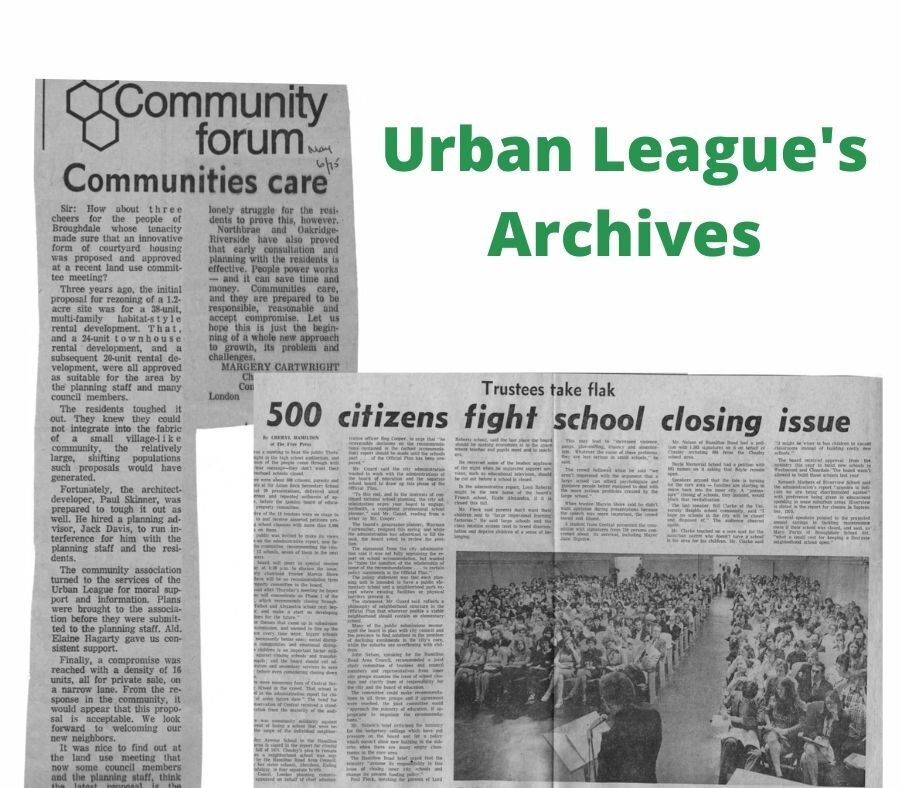Urban League's Archives: Neighbourhood Development and School Closures
The Urban League’s Archives blog series was written by Heather Ellis. Heather Ellis is a local researcher in Southwestern Ontario. She is currently a PhD Candidate at Western University and teaches for the Thames Valley District School Board. Heather's current project explores the lives of London's veterans at Westminster Hospital in the early twentieth century.
Hello and welcome to a special Urban League of London blog series. For the past few months, I have been organising, cataloguing, and archiving the Urban League’s documents since 1969. Once this project is finished, they will be housed in their new home: the Western University Archives. This series highlights some interesting documents I’ve found in the collection and important projects completed by the Urban League.
There’s a saying that goes, what’s old is new again. This can be said for the recurring debate in the London community on how to develop the city. Throughout the 1970s, London’s urban landscape was constantly changing. What this new urban landscape should look like was intensely debated amongst citizens’ groups, city hall, and the press. The Urban League, although only a few years old, was actively involved in these discussions.
I found several newspaper articles from the 1974-1976 that highlight the different issues the Urban League was interested in. Londoners were concerned with the increasing number of high rises in residential areas, which is reminiscent of many current local discussions between neighbourhoods and city hall. In 1975, the Broughdale Community Association consulted with the Urban League to prevent the development of a “38-unit multi-family habitat-style rental development” and a “24-unit townhouse rental development, and a subsequent 20-unit rental development.”[1] With the help of the Urban League, the Broughdale Community Association was able to come to a compromise with the developer for a smaller development that better suited the neighbourhood.
In addition to development issues, the Urban League was interested in the proposed school closures in 1974. London trustees proposed to close several smaller schools across London in favour of larger elementary and secondary schools. Citizens across London vehemently opposed this proposal. 500 citizens gathered at Sir Adam Beck Secondary School on June 13, 1974, to question the school board trustees. Citizens argued that “bigger schools aren’t necessarily better ones; social disruption to communities and emotional disruption to children is an important factor militating against closing schools and transferring pupils; and the board should cut administration and secondary services before even considering closing down schools.”[2]
Among the schools targeted for closure over the next two years was Central Secondary School. Citizens argued that schools were vital community centres for students and the surrounding neighbourhood. Central Secondary School, now operating as London Central Secondary School remains open today, and is ranked 27/739 for high schools in Canada. As we have seen with COVID-19, schools are not only important learning centres for students, they are also important for students’ social and emotional well-being.
The need for more schools in newly developed neighbourhoods is another recurring topic. As new development moves from the core neighbourhoods, older schools like Lorne Ave Public School in Old East Village get closed down due to lower enrollment. Schools like Sir Arthur Currie in the north west end of the city are bursting due to new neighbourhoods in the Hyde Park area being developed and families moving in.
Urban sprawl not only takes valuable greenfield spaces out of production, it also changes the complex fabric of our communities. London has a history of approving low-density neighbourhoods, which requires more and more land in order to provide sufficient housing for the community. Moving forward, in the midst of a climate and affordability crisis, mid and high density developments closer to existing infrastructure services will need to be prioritized, both to create vital and sustainable neighbourhoods, but also to keep our emissions from travel and home heating low.
____________________________________
[1] Margery Cartwright, “Communities Care” May 6, 1975.
[2] Cheryl Hamilton, “Trustees Take Flak 500 Citizens Fight School Closing Issue” The London Free Press, June 14, 1974.

